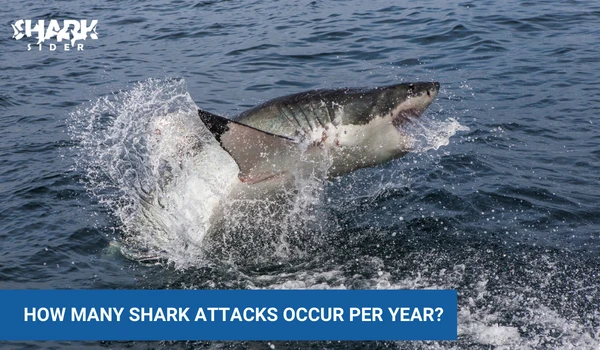Sharks are captivating creatures, known for their impressive power, graceful movements, and stunning beauty. Despite being misunderstood, they continue to be popular subject of study. However, the perception of sharks as overly dangerous animals is often exaggerated in our culture and media. Are you curious about how many shark attacks per year actually occured? In this blog post, we will dive into the statistics and dispel myths surrounding human interactions with these majestic sea creatures. We will provide a more informed perspective on the actual frequency of shark attacks and unravel misconceptions that may distort our understanding of these remarkable animals.

Overview of shark attack statistics
Shark attacks are some of the most feared and sensationalized events in the news. While they are rare, they can be deadly. According to the International Shark Attack File (ISAF), there were around 80 unprovoked attacks globally in 2022, resulting in an average of 5 deaths. Although the United States saw over 30 attacks, Australia followed closely with around 17 annually. So, what can we learn from these statistics to help us better understand and avoid these potentially deadly encounters?
Provoked vs. unprovoked attacks
It’s worth noting that the most common attacks tend to be provoked, with humans initiating contact with sharks either through feeding or attempting to get too close. Unprovoked attacks, where a shark attacks without any apparent cause, are less common. In fact, in 2022, there were 60 unprovoked attacks.
Here are some other interesting facts about shark attacks:
- The most common shark attack month is July.
- The most common shark attack time of day is between 10 am and 4 pm.
- Most shark attacks occur in the Atlantic Ocean.
- The most common shark attack victim is a male between the ages of 15 and 30.
- Only about 5% of shark attacks are fatal.
Factors influencing shark attacks

It’s important to note that the occurrence of shark attacks can be influenced by various factors, including environmental conditions, human activities, and shark behavior. Some of the most important factors that can increase the risk of a shark attack include:
Water temperature – is one of the most significant environmental factors that can influence a shark’s behavior, movement, and ultimately the likelihood of an attack on humans. Sharks are cold-blooded animals, also known as ectothermic, which means their body temperature varies according to the temperature of the water surrounding them. As a result, they are more active in warmer water temperatures. Conversely, when water temperatures are colder during the winter months, sharks tend to move to warmer waters or become less active. This temporary displacement could lead to a sudden influx of typically docile shark species nearer to shore
Prey availability – is an essential environmental factor that plays a critical role in determining the likelihood of a shark attack. Sharks are apex predators that are opportunistic feeders, meaning they go after prey that is readily available when they need it. As such, when there is a high concentration of prey, it can increase the chances of shark attacks.
Sharks are known to target a wide variety of marine life, including seals, sea lions, dolphins, and other sharks. These animals are typically found in coastal waters, and their presence often attracts sharks to the area to feed. When high prey densities occur, sharks may become more aggressive in their hunting behavior, making them more likely to attack potential prey if it is confused with the food supply. For example, a surfer paddling on their surfboard could potentially be mistaken for prey by a shark, leading to a dangerous encounter.
Human activity – is a key factor that affects the likelihood of a shark attack. Sharks are drawn to areas with higher levels of human activity, such as near beaches, piers, and fishing spots on the coast. This is because there is an increased likelihood of sharks encountering humans in these areas due to their presence.
Sharks can be attracted by the smell of bait and fish being used for fishing, as well as the commotion made by people engaging in water activities near them. In addition, when certain oceanic conditions like storms occur, sharks may move further inshore in search of food, making them more likely to encounter humans in shallower waters near shorelines.
Time of day – Sharks are more active at dawn and dusk, which are known as the “shark feeding times.” This is because their prey is also more active during these times.
Weather conditions – Sharks are more likely to attack in calm, clear water. This is because they have better visibility in these conditions, which makes it easier for them to spot prey.
What shark attacks the most?

Research has shown that the most common shark species involved in attacks is the Great White shark, renowned for its size and power. However, other species such as the Tiger shark, the Bull shark, and the Mako shark, have also been known to attack humans. These predators are all capable of causing serious harm to humans, with sharp teeth and powerful jaws that can inflict devastating wounds.
Although sharks are formidable predators, it is essential to note that shark attacks are incredibly rare. With odds of approximately 1 in 3,748,067 of an individual being attacked, one should not be afraid of these fascinating creatures.
However, it is still crucial to be aware of your surroundings when swimming in the ocean, especially in shallow water near the shore. This is because sharks are ambush predators and prefer to attack their prey from below. Being vigilant and paying attention to warning signs and lifeguard instructions can help detect and prevent any potential danger while enjoying time in the water.
By understanding and respecting the ocean and its inhabitants and taking necessary precautions, individuals can continue to experience the joy of swimming and enjoying the marine environment safely.
Where do most shark attacks happen?

The majority of shark attacks occur in coastal regions, particularly in areas where humans engage in activities such as swimming, surfing, and diving. In the United States, for example, the state of Florida has consistently recorded the highest number of shark attacks compared to other states. In 2021, there were 28 unprovoked shark attacks in Florida, accounting for more than half of all unprovoked shark attacks in the world.
This is likely due to the state’s long coastline, warm waters, and popularity as a tourist destination, attracting millions of visitors each year to its beaches and waters. Other U.S. states with notable occurrences of shark attacks include California, Hawaii, and South Carolina.
In Australia, shark attacks are also relatively common, with the eastern and western coasts of the country being known hotspots. In 2021, there were 10 unprovoked shark attacks in Australia, more than in any other country in the world. The state of New South Wales, in particular, has seen a higher number of shark attacks in recent years, likely due to its popular beaches and large coastal population.
In addition to the United States and Australia, other countries with notable occurrences of shark attacks include South Africa, Brazil, and Reunion Island. These areas are known for their populations of certain shark species, such as Great Whites and Bull sharks, which are known to be more aggressive and have been involved in a higher number of shark attacks.
Myths and Misconceptions about shark attacks
Sharks are often portrayed as mindless killers in movies and television shows, but the reality is that they are very complex creatures. There are many myths and misconceptions about sharks, and it is important to understand the facts in order to reduce our fear of these animals.
Here are some of the most common myths about sharks:
- Sharks are always looking for a human to eat. This is simply not true. Sharks are predators, and their primary prey is fish. They only attack humans when they mistake them for their natural prey, or when they feel threatened.
- All sharks are dangerous. There are over 400 species of sharks, and they come in all shapes and sizes. Some sharks, such as the Great White shark, are known to be more aggressive than others. However, the vast majority of sharks are not dangerous to humans.
- Sharks are attracted to human blood. Sharks have a very keen sense of smell, but they are not attracted to human blood. They are more likely to be attracted to the smell of fish or other marine animals.
- There is no way to prevent a shark attack. This is not true. There are a number of things you can do to reduce your risk of being attacked by a shark, such as swimming in areas that are supervised by lifeguards, avoiding swimming at dawn or dusk, and swimming in groups.
Conclusion
Understanding the frequency of shark attacks is crucial for gaining an accurate perception of this topic. Despite sensationalized media coverage, the actual likelihood of encountering a shark and experiencing an attack is statistically insignificant. Global statistics show that shark attacks are relatively rare events, with a consistent frequency over time, albeit with some regional variations. It is important to have a factual understanding of the infrequent nature of shark attacks, rather than being swayed by sensationalism in the media.
